I’d be lying if I told you I love fly fishing during the winter. Maybe, in my teens or twenties, I loved the isolation and the challenge of fishing in harsh conditions. That’s not the case now. As my predecessors explained to me years ago, a cold environment and an aging body don’t mix well. My winter fishing has grown more painful with every lap around the sun. These days, winter also doesn’t provide the solitude it once did, as more anglers take up the sport and realize that good fishing can be had even when temperatures plummet. Nevertheless, I still get excited for fishing with fresh snow on the banks and by being the first angler to create footprints to my favorite wintertime hole. Plus, reading books, watching YouTube videos, attending fly fishing shows, and even tying flies can’t overcome a case of cabin fever, so cold-weather fishing remains my mode of avoiding a case of full-on wintertime depression.
So how do I make the most of winter time on the water? By staying warm, safe, and maximizing my opportunities. In this two-part series focused on winter fishing, I’ll offer tips to help you do the same. First, some pointers on staying comfortable, along with advice for safely returning trout back to the water. The next article will focus on tactics for the winter season.
Cool down before you warm up
Slowly acclimate yourself during your drive to the water. Your body experiences shock when going from extreme heat to extreme cold. I’m not talking about the dangerous or deadly kind of shock, but one that induces discomfort. I love cranking the heat in my car when driving to work, the grocery store, or running my teenage kids around. But the worst part of getting out of your toasty vehicle and into the cold is the initial shock of going from one extreme to the other.
When enroute to fish, I prefer to wear light layers and turn the heat down anytime I’m within 10-15 minutes of my destination. That way, when I open the car door, put on a heavy jacket, and wader-up, I don’t experience as much discomfort. In fact, when I put on my heavy jacket, extra socks, and waders, it feels like I’m warming up.
Get bootfoot waders
While stockingfoot waders are far and away the most popular option, they lack the insulation and warmth offered by the construction of bootfoot waders. From my teens through my late 30s, I used stockingfoot waders during the cold season with little discomfort. During my 40s, I noticed I was getting cold despite wearing extra socks and layers and even after purchasing larger wading boots to allow for better circulation while wearing an extra pair of socks. Five years ago, I made the switch to bootfoot waders — which have an insulated type of muck book attached directly to the wader — and I’ve never had cold feet since, despite fishing during some extreme cold-weather events.
While several reputable fly fishing manufacturers make excellent bootfoot waders, they often come at a high cost. For me, it was worth the cost, as my pair of bootfoot waders have lasted me over 5 years and have made fishing in the winter comfortable and sometimes downright cozy. And you don’t need to break the bank, as there are plenty of lower-cost bootfoot options available.
If you plan to do a decent amount of winter season fishing, bootfoot waders may be a good investment.
Latex gloves and towels
Anyone who has fished during cold weather knows that the moment water meets any exposed part of the body is when the cold burn sets in. Your hands will be exposed to moisture anytime you need to release a fish or strip a fly line. Whatever the reason, the moment your hands get wet is the same moment a painful burning sensation sets in and renders your hands and fingertips useless until they warm up. Last week, one of my flies fell off my fly patch, so I stuck my hand into the water. I saved the fly but it took 10 minutes to warm my hand up and get it back in action.

Wool and fleece gloves are good for keeping your hands warm but can’t help once your fingertips connect with water. This is why a lot of anglers use latex (or similar non-latex alternatives) gloves as a base layer and may wear a pair of fingerless fleece or wool gloves overtop for extra warmth. An additional advantage of latex is they allow you to retain some dexterity to tie knots and manage your fly line. Personally, I prefer wearing fingerless gloves over bare hands and bringing along a small hand towel to wipe my hands anytime they get wet, but a lot of winter regulars favor the latex option these days.
C&R Concerns
Keeping a fish wet may be more important during extreme cold weather than at any other time of the year. By extreme cold I mean when air temperatures drop below 32 degrees. This is why I no longer take the typical grip and grin shot of an angler holding a fish out of the water during such conditions. Trout have delicate gills and there’s a good chance that irreversible damage is done when trout are held out of water for an extended period, allowing their gills to freeze. I now use a net during the winter months so I can keep fish in the water and reduce the time a trout’s gills are exposed to cold air temperatures. If air temperatures are above freezing, keep the fish close to the water’s surface, do a (very) quick lift out of the water, and immediately put it back. But only do this when temps are above freezing and there is no chance of exposing a trout’s gills to freezing air temperatures.
This is part 1 of a two-part series on winter fly fishing. Part 2 can be found here.






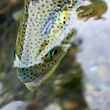
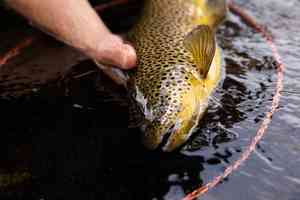

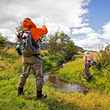
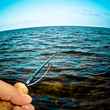



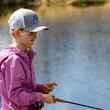

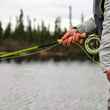

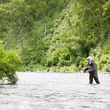
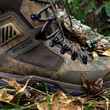
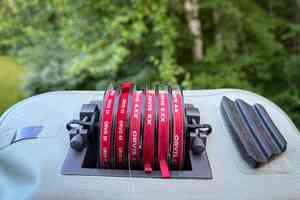
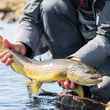
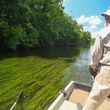

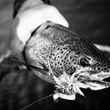





Comments